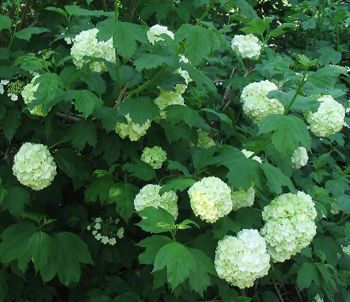Contents:
Common Names | Parts Usually Used | Plant(s) & Culture | Where Found | Medicinal Properties | Biochemical Information
Legends, Myths and Stories | Uses | Formulas or Dosages | Nutrient Content | How Sold | Warning | Bibliography
Scientific Names

- Viburnum opulus L.
- Caprifoliaceae
- Honeysuckle family
Common Names
- Crampbark high
- High cranberry
- Highbush cranberry
- Snowball tree
- Guelder rose
- Squaw bush
Parts Usually Used
Bark
Back to Top
Description of Plant(s) and Culture
Crampbark is a large, handsome, upright shrub or tree; to 12 feet high; leaves maple-like, with 3-5 lobes, hairy beneath. The leaf stalks have a narrow groove, and a disk-shaped gland. Leaves have three lobes and are broadly wedge-shaped. White flowers in a rounded head, to 4 inches across; April to June. Flowers are showy and are succeeded by red, very acid berries, resembling low cranberries, and sometimes substituted for them. Flower clusters have inner fertile flowers, outer sterile ones. They remain on the bush after the leaves have fallen and throughout the winter. The bark has no smell, but has a peculiar bitterish and astringent taste, which leaves a clean taste in the mouth. Viburnine is the active principle found in the dried bark of the stem.
Back to Top
Where Found
Found in the northern part of the United States and Canada. Grows in low rich lands, woods, and borders of fields.
Back to Top
Medicinal Properties
Antispasmodic, nervine, tonic, astringent, diuretic
Back to Top
Biochemical Information
Viburnine, chlorogenic acid, beta-sitosterol, and ursolic acid, vitamins C and K
Back to Top
Legends, Myths and Stories
This plant was well known to the Native Americans.
Crampbark was also a favorite of the horse and buggy doctors. They were known to say, “make a strong tea of the high cranberry bush bark, and drink 1/3 of a tsp. and it will stop cramp in 20 minutes”. To prevent recurrence of the trouble they suggested drinking the tea night and morning for a couple of weeks.
Back to Top
Uses
As the name implies, crampbark relieves cramps and spasms of involuntary muscular contractions such as in asthma, hysteria, convulsions, cramps during pregnancy (preventing the attack entirely if used daily for the last 2-3 months of gestation. Also, relieves dysmenorrhea, labor pains, headache, neuralgia, earaches, epididymitis, lumbago, miscarriage, paralysis, tubercular lungs, with honey for high blood pressure, heart conditions, bladder, constipation, stomach cramps, cough, cold, fever, flu, sclerosis, eczema, scrofula, and skin conditions.
The low cranberry and possibly the high cranberry is known to be a direct medication for erysipelas. If applied early, externally, this condition yields at once. Also for malignant ulcers and scarlet fever when applied to the throat. Pound the berries and spread them in a fold of old cotton cloth and apply over the entire diseased surface and the inflammation will speedily subside. Its usefulness is universally acknowledged.
In China, leaves and fruit are used as an emetic, laxative, and antiscorbutic.
Back to Top
Formulas or Dosages
Infusion: steep 1 tsp. of the cut bark in 1 cup boiling water for 30 minutes; when cold, drink 1-2 cups a day.
Tincture: 1/2 fl. dram.
Back to Top
Nutrient Content
The berries are rich in vitamins C and K.
Back to Top
How Sold
Capsules, extract
Back to Top
Warning
Berries are considered potentially poisonous; they contain chlorogenic acid, beta-sitosterol, and ursolic acid, at least when they are unripe.
Back to Top
Bibliography
![]() Eastern/Central Medicinal Plants
Eastern/Central Medicinal Plants, by Steven Foster and James A. Duke., Houghton Mifflin Company, 215 Park Avenue South, New York, NY 10000
![]() The Nature Doctor: A Manual of Traditional and Complementary Medicine
The Nature Doctor: A Manual of Traditional and Complementary Medicine, by Dr. H.C.A. Vogel; Keats Publishing, Inc., 27 Pine Street (Box 876) New Canaan, CT. 06840-0876. Copyright Verlag A. Vogel, Teufen (AR) Switzerland 1952, 1991
![]() Planetary Herbology
Planetary Herbology, by Michael Tierra, C.A., N.D., O.M.D., Lotus Press, PO Box 325, Twin Lakes. WI 53181., Copyright 1988, published 1992
![]() The Complete Medicinal Herbal
The Complete Medicinal Herbal, by Penelope Ody, Dorling Kindersley, Inc, 232 Madison Avenue, New York, NY 10016, First American Edition, copyright 1993
![]() Indian Herbalogy of North America
Indian Herbalogy of North America, by Alma R. Hutchens, Shambala Publications, Inc., Horticultural Hall, 300 Massachusetts Avenue, Boston, Massachusetts 02115, 1973
![]() American Folk Medicine
American Folk Medicine, by Clarence Meyer, Meyerbooks, publisher, PO Box 427, Glenwood, Illinois 60425, 1973
![]() Webster’s New World Dictionary
Webster’s New World Dictionary, Third College Edition, Victoria Neufeldt, Editor in Chief, New World Dictionaries: A Division of Simon & Schuster, Inc., 15 Columbus Circle, New York, NY 10023
 How Indians Use Wild Plants for Food, Medicine & Crafts
How Indians Use Wild Plants for Food, Medicine & Crafts, by Frances Densmore, Dover Publications, Inc., 180 Varick Street, New York, NY 10014, first printed by the United States Government Printing Office, Washington, in 1928, this Dover edition 1974
 An Instant Guide to Medicinal Plants
An Instant Guide to Medicinal Plants, by Pamela Forey and Ruth Lindsay, Crescent Books (January 27, 1992).
 The Magic of Herbs in Daily Living
The Magic of Herbs in Daily Living, by Richard Lucas, Parker Publishing Co. (1988).
![]() The Yoga of Herbs: An Ayurvedic Guide to Herbal Medicine
The Yoga of Herbs: An Ayurvedic Guide to Herbal Medicine, by Dr. David Frawley & Dr. Vasant Lad, Lotus Press, Twin Lakes, Wisconsin, Second edition, 1988.
 A Useful Guide to Herbal Health Care
A Useful Guide to Herbal Health Care, HCBL (Health Center for Better Living).,1414 Rosemary Lane, Naples, FL 34103., Special Sale Catalog, 1996
 The Rodale Herb Book: How to Use, Grow, and Buy Nature’s Miracle Plants (An Organic gardening and farming book)
The Rodale Herb Book: How to Use, Grow, and Buy Nature’s Miracle Plants (An Organic gardening and farming book), edited by William H. Hylton, Rodale Press, Inc. Emmaus, PA, 18049., 1974
